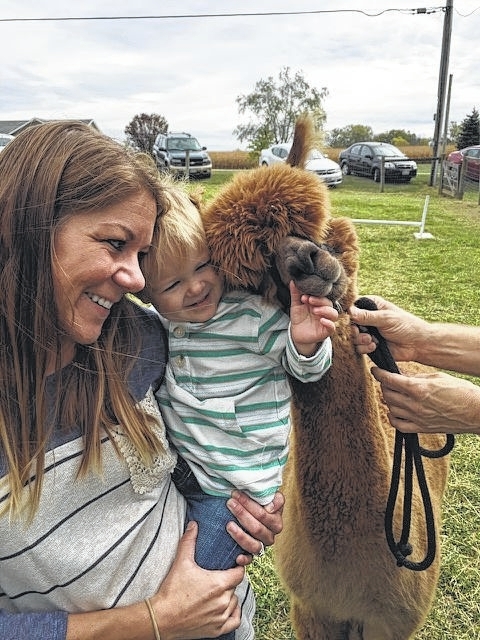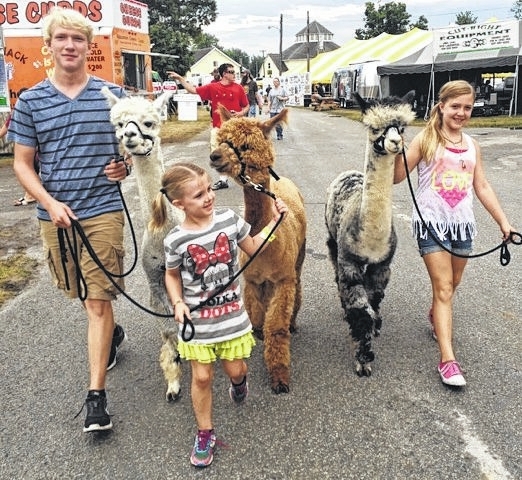

SIDNEY — Count Your Blessings Alpacas will celebrate its 10th anniversary during National Alpaca Farm Days on Saturday, Sept. 24.
Rick and Annette Paulus will host visitors to their farm from 11 a.m. to 5 p.m. on Sept. 24. Their farm is located at 680 Doorley Road, Sidney.
There will be many activities, including petting, feeding and leading alpacas, demonstrations, alpaca obstacle coarse, door prizes, hay ride, or just come and relax for a while, enjoy food and refreshments, and listen to the music by Jeff Newland and the hummmm of the alpacas. Alpaca products will be on display and available for purchase if interested. The event is free to the public.
National Alpaca Farm Days allows alpaca breeders from across the United States and Canada to invite the public to come to their farms or ranches to meet their alpacas and learn more about these inquisitive, unique animals, the luxury fiber they produce, and why the alpaca business is perfect for environmentally conscious individuals.
About alpacas
Alpacas, cousins to the llama, are beautiful, intelligent animals native to the Andean Mountain range of South America, particularly Peru, Bolivia and Chile.
Today, the United States boasts two types of alpacas. Although almost physically identical, the two types of alpacas are distinguished by their fiber. The Huacaya (wa-Ki’-ah) is the more common of the two and has a fluffy, extremely fine coat. On the other hand, the Suri (SUR-ee) is more rare and has fiber that is silky and resembles pencil-locks.
Adult alpacas stand at approximately 36 inches at the withers and generally weigh between 150 and 200 pounds. They do not have horns, hooves, claws, or incisors. Alpacas are alert, intelligent, curious, and predictable. They are social animals that seek companionship and communicate most commonly by softly humming.
About alpaca fiber
Long ago, alpaca fiber was reserved for royalty. Today, it is sold several ways. Hand-spinners and fiber artists buy raw fleece. Knitters often purchase alpaca yarn. Fiber cooperatives mills collect alpaca fiber and process it on behalf of the producer.
Alpacas are shorn, without harm, every 12 to 18 months. An adult alpaca might produce 50 to 90 ounces of first-quality fiber as well as 50 to 100 ounces of second and third quality fiber. Some alpacas already achieve, or exceed, these levels.
Because of its soft texture, alpaca fiber is sometimes compared to cashmere. The fiber also has the luster of silk, making it even more coveted. Alpaca is just as warm as wool, yet it is a mere 1/3 the weight. It comes in 16 natural colors and can be dyed any desired shade.
Containing no lanolin, alpaca fiber is also naturally hypoallergenic. Most people who are sensitive to wool find that they can wear alpaca without the itching or irritation they feel from wool because alpaca fiber is smooth. Additional performance characteristics include stretch, water repellency and odor reduction. For travelers, clothing made from alpaca is desirable because it is wrinkle-resistant.
Today’s consumer searches for high-quality, environmentally sound products made of naturally renewable resources. The alpaca provides fiber, just as it has for thousands of years, to create colorful garments that are soft to the touch. Classically styled alpaca sweaters and suits can last for generations.
Socks, scarves, purses, golf shirts, teddy bears, and blankets are just a few additional items made from North American alpaca fiber currently on the market.
Green alpacas?
Alpacas come in 16 natural colors, but they are all green!
Sensitive to their environment in every respect, alpacas have soft padded feet instead of hooves and can leave even the most delicate terrain undamaged. Damage to topsoil decreases long-term soil fertility and in the process, the soil is eroded and weed invasion is encouraged.
Alpacas prefer to eat tender grasses, which they do not pull up by the roots. Lacking upper teeth, alpacas “cut” the grass with their bottom teeth and upper palate. This vegetation cutting encourages the plants’ growth. Because they are modified ruminants with a three-compartment stomach, alpacas convert grass and hay to energy very efficiently, and stop eating when they are full, further preserving the landscape on which they live.
However, alpacas do not mind eating brush, fallen leaves and other “undesirable” vegetation, leaving the “good stuff” for species that do not have the stomach to digest such roughage.
Alpacas’s pellet-like droppings are PH balanced, and an excellent, natural, slow release, low odor fertilizer. This rich fertilizer is perfect for growing fruits and vegetables. Because alpacas consolidate their feces in one or two communal spots in the pasture, it is easy to collect and compost, and the spread of parasites is controlled.
While alpacas are environmentally friendly … and even beneficial … to the land, what makes them even more “green” is the fiber they produce. No chemicals are employed either during feeding or during the industrial production of alpaca fleece into fiber. If dying is desired, only 20 percent of a normal dye quantity is required.
All fiber from an alpaca can be used. Even the fiber from the lower legs, belly, neck, etc is being used for things such as natural weed mats to be placed around trees. Alpaca fiber is biodegradable.
To find out more about National Alpaca Farm Days, visit www.alpacafarmdays.com. To learn more about Count Your Blessings Alpacas, call 937-497-0944 or find Count Your Blessings Alpacas on Facebook.



